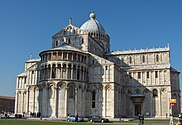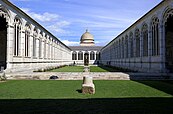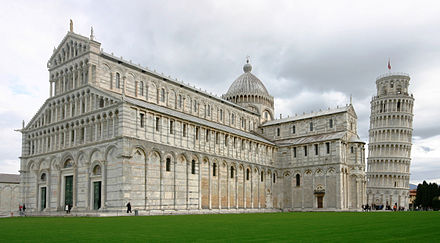Pisa
Pisa | |
|---|---|
| Comune di Pisa | |
Historic centre of Pisa on theArno | |
| Coordinates:43°43′N10°24′E/ 43.717°N 10.400°E | |
| Country | Italy |
| Region | Tuscany |
| Province | Pisa(PI) |
| Frazioni | Calambrone,Coltano,Marina di Pisa,San Piero a Grado,Tirrenia |
| Government | |
| • Mayor | Michele Conti |
| Area | |
| • Total | 185 km2(71 sq mi) |
| Elevation | 4 m (13 ft) |
| Population (July 31, 2023)[2] | |
| • Total | 98,778[1] |
| Demonym(s) | Pisano Pisan (English) |
| Time zone | UTC+1(CET) |
| • Summer (DST) | UTC+2(CEST) |
| Postal code | 56121–56128 |
| Dialing code | 050 |
| ISTATcode | 050026 |
| Patron saint | San Ranieri |
| Saint day | June 17 |
| Website | Official website |
Pisa(/ˈpiːzə/PEE-zə;Italian:[ˈpiːza]or[ˈpiːsa][3]) is a city andcomune(municipality) inTuscany,central Italy, straddling theArnojust before it empties into theLigurian Sea.It is the capital city of theProvince of Pisa.Although Pisa is known worldwide for itsleaning tower,the city contains more than twenty other historic churches, several medieval palaces, and bridges across the Arno. Much of the city's architecture was financed from its history as one of the Italianmaritime republics.
The city is also home to theUniversity of Pisa,which has a history going back to the 12th century, theScuola Normale Superiore di Pisa,founded by Napoleon in 1810, and its offshoot, theSant'Anna School of Advanced Studies.[4]
History
[edit]This sectionneeds additional citations forverification.(June 2024) |
Ancient times
[edit]Most believe the hypothesis that the origin of the name Pisa comes fromEtruscanand means 'mouth', as Pisa is at the mouth of the Arno river.[5]
Although throughout history there have been several uncertainties about the origin of the city of Pisa, excavations made in the 1980s and 1990s found numerous archaeological remains, including the fifth century BC tomb of an Etruscan prince, proving theEtruscanorigin of the city, and its role as a maritime city, showing that it also maintained trade relations with other Mediterranean civilizations.[6]
Ancient Romanauthors referred to Pisa as an old city.Virgil,in hisAeneid,states that Pisa was already a great center by the times described; and gives the epithet ofAlphēaeto the city because it was said to have been founded by colonists fromPisainElis,near which theAlpheius riverflowed.[7]The Virgilian commentatorServiuswrote that the Teuti founded the town 13 centuries before the start of the common era.
The maritime role of Pisa should have been already prominent if the ancient authorities ascribed to it the invention of thenaval ram.Pisa took advantage of being the only port along the western coast betweenGenoa(then a small village) andOstia.Pisa served as a base for Roman naval expeditions againstLiguriansandGauls.In 180 BC, it became a Roman colony under Roman law, asPortus Pisanus.In 89 BC,Portus Pisanusbecame amunicipium.EmperorAugustusfortified the colony into an important port and changed the name toColonia Iulia obsequens.
Pisa supposedly was founded on the shore, but due to the alluvial sediments from the Arno and the Serchio, whose mouth lies about 11 km (7 mi) north of the Arno's, the shore moved west. Strabo states that the city was 4.0 km (2.5 mi) away from the coast. Currently, it is located 9.7 km (6 mi) from the coast. However, it was a maritime city, with ships sailing up the Arno.[8]In the 90s AD, abaths complexwas built in the city.
Late Antiquity and Early Middle Ages
[edit]
During the last years of theWestern Roman Empire,Pisa did not decline as much as the other cities of Italy, probably due to the complexity of its river system and its consequent ease of defence. In the seventh century, Pisa helpedPope Gregory Iby supplying numerous ships in his military expedition against theByzantinesofRavenna(what "military expedition by Pope Gregory against the Byzantine Empire"[citation needed]): Pisa was the sole Byzantine centre ofTusciato fall peacefully inLombardhands, through assimilation with the neighbouring region where their trading interests were prevalent. Pisa began in this way its rise to the role of main port of the Upper Tyrrhenian Sea and became the main trading centre between Tuscany andCorsica,Sardinia,and the southern coasts of France and Spain.
AfterCharlemagnehad defeated the Lombards under the command ofDesideriusin 774, Pisa went through a crisis, but soon recovered. Politically, it became part of the duchy ofLucca.In 860, Pisa was captured byvikingsled byBjörn Ironside.In 930, Pisa became the county centre (status it maintained until the arrival ofOtto I) within the mark ofTuscia.Lucca was the capital but Pisa was the most important city, as in the middle of tenth centuryLiutprand of Cremona,bishop ofCremona,called PisaTusciae provinciae caput( "capital of the province of Tuscia" ), and a century later, the marquis of Tuscia was commonly referred to as "marquis of Pisa". In 1003, Pisa was the protagonist of the firstcommunalwar in Italy, against Lucca. From the naval point of view, since the ninth century, the emergence of theSaracenpirates prompted the city to expand its fleet. In the following years, this fleet gave the town an opportunity for more expansion. In 828, Pisan ships assaulted the coast ofNorth Africa.In 871, they took part in the defence ofSalernofrom the Saracens. In 970, they gave also strong support toOtto I'sexpedition, defeating a Byzantine fleet in front ofCalabresecoasts.
11th century
[edit]
The power of Pisa as a maritime nation began to grow and reached its apex in the 11th century, when it acquired traditional fame as one of the four main historicalmaritime republicsof Italy (Repubbliche Marinare).
At that time, the city was a very important commercial centre and controlled a significantMediterraneanmerchant fleet and navy. It expanded its powers in 1005 through the sack ofReggio Calabriain the south of Italy. Pisa was in continuous conflict with some 'Saracens' - a medieval term to refer to ArabMuslims- who had their bases in Corsica, for control of the Mediterranean. In 1017,SardinianGiudicatiwere militarily supported by Pisa, in alliance with Genoa, to defeat the Saracen King Mugahid, who had settled a logistic base in the north of Sardinia the year before. This victory gave Pisa supremacy in theTyrrhenian Sea.When the Pisans subsequently ousted the Genoese from Sardinia, a new conflict and rivalry was born between these major marine republics. Between 1030 and 1035, Pisa went on to defeat several rival towns in Sicily and conquerCarthageinNorth Africa.In 1051–1052, the admiral Jacopo Ciurini conqueredCorsica,provoking more resentment from the Genoese. In 1063, Admiral Giovanni Orlandi, coming to the aid of theNormanRoger I,tookPalermofrom the Saracen pirates. The gold treasure taken from the Saracens in Palermo allowed the Pisans to start the building of their cathedral and the other monuments which constitute the famousPiazza del Duomo.
In 1060, Pisa engaged in its first battle withGenoa.The Pisan victory helped to consolidate its position in the Mediterranean.Pope Gregory VIIrecognised in 1077 the new "Laws and customs of the sea" instituted by the Pisans, and emperorHenry IVgranted them the right to name their own consuls, advised by a council of elders. This was simply a confirmation of the present situation, because in those years, the marquis had already been excluded from power. In 1092,Pope Urban IIawarded Pisa the supremacy over Corsica and Sardinia, and at the same time raising the town to the rank of archbishopric.
Pisa sacked theTunisiancity ofMahdiain 1088. Four years later, Pisan and Genoese ships helpedAlfonso VI of Castillato pushEl Cidout ofValencia.A Pisan fleet of 120 ships also took part in theFirst Crusade,and the Pisans were instrumental in the taking ofJerusalemin 1099. On their way to theHoly Land,the ships did not miss the occasion to sack some Byzantine islands; the Pisan crusaders were led by their archbishopDaibert,the futurepatriarch of Jerusalem.Pisa and the otherRepubbliche Marinaretook advantage of the crusade to establish trading posts and colonies in the Eastern coastal cities of theLevant.In particular, the Pisans founded colonies inAntiochia,Acre,Jaffa,Tripoli,Tyre,Latakia,and Accone. They also had other possessions inJerusalemandCaesarea,plus smaller colonies (with lesser autonomy) inCairo,Alexandria,and of courseConstantinople,where theByzantine EmperorAlexius I Comnenusgranted them special mooring and trading rights. In all these cities, the Pisans were granted privileges and immunity from taxation, but had to contribute to the defence in case of attack. In the 12th century, the Pisan quarter in the eastern part of Constantinople had grown to 1,000 people. For some years of that century, Pisa was the most prominent commercial and military ally of the Byzantine Empire, overcomingVeniceitself.
12th century
[edit]In 1113, Pisa andPope Paschal IIset up, together with the count ofBarcelonaand other contingents fromProvenceand Italy (Genoese excluded),a war to free the Balearic Islandsfrom theMoors;the queen and the king ofMajorcawere brought in chains to Tuscany. Though theAlmoravidessoon reconquered the island, the booty taken helped the Pisans in their magnificent programme of buildings, especially thecathedral,and Pisa gained a role of pre-eminence in theWestern Mediterranean.
In the following years, the powerful Pisan fleet, led by archbishopPietro Moriconi,drove away the Saracens after ferocious battles. Though short-lived, this Pisan success in Spain increased the rivalry with Genoa. Pisa's trade withLanguedoc,Provence(Noli,Savona,Fréjus,andMontpellier) were an obstacle to Genoese interests in cities such asHyères,Fos,Antibes,andMarseille.
The war began in 1119 when the Genoese attacked several galleys on their way home to the motherland, and lasted until 1133. The two cities fought each other on land and at sea, but hostilities were limited to raids and pirate-like assaults.
In June 1135,Bernard of Clairvauxtook a leading part in theCouncil of Pisa,asserting the claims of PopeInnocent IIagainst those of PopeAnacletus II,who had been elected pope in 1130 withNormansupport, but was not recognised outside Rome. Innocent II resolved the conflict with Genoa, establishing Pisan and Genoese spheres of influence. Pisa could then, unhindered by Genoa, participate in the conflict of Innocent II against kingRoger II of Sicily.Amalfi,one of the maritime republics (though already declining under Norman rule), was conquered on August 6, 1136; the Pisans destroyed the ships in the port, assaulted the castles in the surrounding areas, and drove back an army sent by Roger fromAversa.This victory brought Pisa to the peak of its power and to a standing equal to Venice. Two years later, its soldiers sackedSalerno.
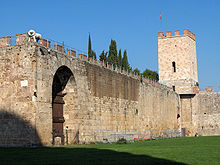
In the following years, Pisa was one of the staunchest supporters of theGhibellineparty. This was much appreciated byFrederick I.He issued in 1162 and 1165 two important documents, with these grants: Apart from the jurisdiction over the Pisan countryside, the Pisans were granted freedom of trade in the whole empire, the coast fromCivitavecchiatoPortovenere,a half ofPalermo,Messina,SalernoandNaples,the whole ofGaeta,Mazara,andTrapani,and a street with houses for its merchants in every city of theKingdom of Sicily.Some of these grants were later confirmed byHenry VI,Otto IV,andFrederick II.They marked the apex of Pisa's power, but also spurred the resentment of other cities such asLucca,Massa,Volterra,andFlorence,thwarting their aim to expand towards the sea. The clash with Lucca also concerned the possession of the castle ofMontignosoand mainly the control of theVia Francigena,the main trade route between Rome and France. Last, but not least, such a sudden and large increase of power by Pisa could only lead to another war with Genoa.
Genoa had acquired a dominant position in the markets of southern France. The war began in 1165 on theRhône,when an attack on a convoy, directed to some Pisan trade centres on the river, by the Genoese and their ally, the count ofToulouse,failed. Pisa, though, was allied to Provence. The war continued until 1175 without significant victories. Another point of attrition wasSicily,where both the cities had privileges granted byHenry VI.In 1192, Pisa managed to conquer Messina. This episode was followed by a series of battles culminating in the Genoese conquest ofSyracusein 1204. Later, the trading posts in Sicily were lost when the newPope Innocent III,though removing theexcommunicationcast over Pisa by his predecessorCelestine III,allied himself with theGuelph Leagueof Tuscany, led by Florence. Soon, he stipulated[clarification needed]a pact with Genoa, too, further weakening the Pisan presence in southern Italy.
To counter the Genoese predominance in the southern Tyrrhenian Sea, Pisa strengthened its relationship with its traditional Spanish and French bases (Marseille,Narbonne,Barcelona,etc.) and tried to defy theVenetianrule of theAdriatic Sea.In 1180, the two cities agreed to a nonaggression treaty in the Tyrrhenian and the Adriatic, but the death of EmperorManuel Comnenusin Constantinople changed the situation. Soon, attacks on Venetian convoys were made. Pisa signed trade and political pacts withAncona,Pula,Zara,Split,andBrindisi;in 1195, a Pisan fleet reached Pola to defend its independence from Venice, but the Serenissima soon reconquered the rebel sea town.
One year later, the two cities signed a peace treaty, which resulted in favourable conditions for Pisa, but in 1199, the Pisans violated it by blockading theport of BrindisiinApulia.In the following naval battle, they were defeated by the Venetians. The war that followed ended in 1206 with a treaty in which Pisa gave up all its hopes to expand in the Adriatic, though it maintained the trading posts it had established in the area. From that point on, the two cities were united against the rising power of Genoa and sometimes collaborated to increase the trading benefits in Constantinople.
13th century
[edit]In 1209 inLerici,two councils for a final resolution of the rivalry with Genoa were held. A 20-year peace treaty was signed, but when in 1220, the emperorFrederick IIconfirmed his supremacy over theTyrrheniancoast fromCivitavecchiatoPortovenere,the Genoese and Tuscan resentment against Pisa grew again. In the following years, Pisa clashed with Lucca inGarfagnanaand was defeated by theFlorentinesat Castel del Bosco. The strongGhibellineposition of Pisa brought this town diametrically against the Pope, who was in a dispute with theHoly Roman Empire,and indeed the pope tried to deprive Pisa of its dominions in northernSardinia.
In 1238,Pope Gregory IXformed an alliance between Genoa and Venice against the empire, and consequently against Pisa, too. One year later, he excommunicated Frederick II and called for an anti-Empire council to be held in Rome in 1241. On May 3, 1241, a combined fleet of Pisan and Sicilian ships, led by the emperor's sonEnzo,attacked a Genoese convoy carrying prelates from northern Italy and France, next to the isle ofGiglio(Battle of Giglio), in front ofTuscany;the Genoese lost 25 ships, while about a thousand sailors, two cardinals, and one bishop were taken prisoner. After this major victory, the council in Rome failed, but Pisa was excommunicated. This extreme measure was only removed in 1257. Anyway, the Tuscan city tried to take advantage of the favourable situation to conquer the Corsican city ofAleriaand even lay siege to Genoa itself in 1243.
TheLigurianrepublic of Genoa, however, recovered fast from this blow and won backLerici,conquered by the Pisans some years earlier, in 1256.
The great expansion in the Mediterranean and the prominence of the merchant class urged a modification in the city's institutes. The system with consuls was abandoned, and in 1230, the new city rulers named acapitano del popolo( "people's chieftain" ) as civil and military leader. Despite these reforms, the conquered lands and the city itself were harassed by the rivalry between the two families ofDella GherardescaandVisconti.In 1237 the archbishop and the Emperor Frederick II intervened to reconcile the two rivals, but the strains continued. In 1254, the people rebelled and imposed 12Anziani del Popolo( "People's Elders" ) as their political representatives in the commune. They also supplemented the legislative councils, formed of noblemen, with new People's Councils, composed by the main guilds and by the chiefs of the People's Companies. These had the power to ratify the laws of the Major General Council and the Senate.
Decline
[edit]
The decline is said to have begun on August 6, 1284, when the numerically superior fleet of Pisa, under the command ofAlbertino Morosini,was defeated by the brilliant tactics of the Genoese fleet, under the command ofBenedetto ZaccariaandOberto Doria,in the dramatic navalBattle of Meloria.This defeat ended the maritime power of Pisa and the town never fully recovered; in 1290, the Genoese destroyed forever the Porto Pisano (Pisa's port), andcovered the land with salt.The region around Pisa did not permit the city to recover from the loss of thousands of sailors from the Meloria, while Liguria guaranteed enough sailors to Genoa. Goods, however, continued to be traded, albeit in reduced quantity, but the end came when the Arno started to change course, preventing the galleys from reaching the city's port up the river. The nearby area also likely became infested withmalaria.The true end came in 1324, when Sardinia was entirely lost to theAragonese.
Always Ghibelline, Pisa tried to build up its power in the course of the 14th century, and even managed to defeatFlorencein theBattle of Montecatini(1315), under the command ofUguccione della Faggiuola.Eventually, however, after a long siege, Pisa was occupied by Florentines in 1405.[9]Florentines corrupted thecapitano del popolo( "people's chieftain" ), Giovanni Gambacorta, who at night opened the city gate of San Marco. Pisa was never conquered by an army. In 1409, Pisa was the seat of acounciltrying to set the question of theGreat Schism.In the 15th century, access to the sea became more difficult, as the port was silting up and was cut off from the sea. When in 1494,Charles VIII of Franceinvaded the Italian states to claim theKingdom of Naples,[9]Pisa reclaimed its independence as the Second Pisan Republic.

The new freedom did not last long; 15 years of battles and sieges by the Florentine troops led byAntonio da Filicaja,Averardo SalviatiandNiccolò Capponiwere made, but they failed to conquer the city.Vitellozzo Vitelliwith his brotherPaolowere the only ones who actually managed to break the strong defences of Pisa and make a breach in the Stampace bastion in the southern west part of the walls, but he did not enter the city. For that, they were suspected of treachery and Paolo was put to death. However, the resources of Pisa were getting low, and at the end, the city was sold to the Visconti family from Milan and eventually to Florence again.Livornotook over the role of the main port of Tuscany. Pisa acquired a mainly cultural role spurred by the presence of theUniversity of Pisa,created in 1343, and later reinforced by theScuola Normale Superiore di Pisa(1810) andSant'Anna School of Advanced Studies(1987).
Pisa was the birthplace of the important early physicistGalileo Galilei.It is still the seat of anarchbishopric.Besides its educational institutions, it has become a light industrial centre and a railway hub. It suffered repeated destruction duringWorld War II.
Since the early 1950s, the US Army has maintainedCamp Darbyjust outside Pisa, which is used by many US military personnel as a base for vacations in the area.[10][11]
Geography
[edit]Climate
[edit]Pisa has a borderlinehumid subtropical climate(Köppen climate classification:Cfa) andMediterranean climate(Köppen climate classification:Csa). The city is characterized by cool to mild winters and hot summers. This transitional climate allows Pisa to have summers with moderaterainfall.Rainfall peaks in autumn.Snowis rare. The highest officially recorded temperature was 39.5 °C (103.1 °F) on 22 August 2011 and the lowest was −13.8 °C (7.2 °F) on 12 January 1985.[12][13]
| Climate data for Pisa (1991–2020 normals) | |||||||||||||
|---|---|---|---|---|---|---|---|---|---|---|---|---|---|
| Month | Jan | Feb | Mar | Apr | May | Jun | Jul | Aug | Sep | Oct | Nov | Dec | Year |
| Record high °C (°F) | 17.6 (63.7) |
21.0 (69.8) |
24.0 (75.2) |
27.9 (82.2) |
30.9 (87.6) |
35.0 (95.0) |
37.8 (100.0) |
39.5 (103.1) |
36.2 (97.2) |
30.2 (86.4) |
24.0 (75.2) |
20.4 (68.7) |
39.5 (103.1) |
| Mean daily maximum °C (°F) | 11.5 (52.7) |
12.6 (54.7) |
15.5 (59.9) |
18.5 (65.3) |
22.7 (72.9) |
27.0 (80.6) |
29.9 (85.8) |
30.3 (86.5) |
26.1 (79.0) |
21.3 (70.3) |
16.0 (60.8) |
12.1 (53.8) |
20.3 (68.5) |
| Daily mean °C (°F) | 6.9 (44.4) |
7.4 (45.3) |
10.2 (50.4) |
13.0 (55.4) |
17.1 (62.8) |
21.2 (70.2) |
23.9 (75.0) |
24.2 (75.6) |
20.2 (68.4) |
16.1 (61.0) |
11.6 (52.9) |
7.7 (45.9) |
15.0 (58.9) |
| Mean daily minimum °C (°F) | 2.8 (37.0) |
2.8 (37.0) |
5.2 (41.4) |
7.8 (46.0) |
11.5 (52.7) |
15.3 (59.5) |
17.8 (64.0) |
18.5 (65.3) |
14.9 (58.8) |
11.7 (53.1) |
7.8 (46.0) |
3.9 (39.0) |
10.0 (50.0) |
| Record low °C (°F) | −13.8 (7.2) |
−8.4 (16.9) |
−8.2 (17.2) |
−3.2 (26.2) |
2.8 (37.0) |
5.8 (42.4) |
8.8 (47.8) |
8.2 (46.8) |
3.8 (38.8) |
0.3 (32.5) |
−7.2 (19.0) |
−7.2 (19.0) |
−13.8 (7.2) |
| Averageprecipitationmm (inches) | 68.0 (2.68) |
63.1 (2.48) |
60.0 (2.36) |
64.9 (2.56) |
61.7 (2.43) |
41.1 (1.62) |
31.9 (1.26) |
40.6 (1.60) |
100.3 (3.95) |
128.7 (5.07) |
131.1 (5.16) |
87.7 (3.45) |
879.1 (34.62) |
| Average precipitation days(≥ 1.0 mm) | 6.9 | 7.2 | 6.3 | 7.6 | 6.6 | 4.4 | 2.2 | 2.6 | 6.5 | 8.6 | 10.4 | 9.3 | 78.6 |
| Averagerelative humidity(%) | 75.2 | 71.9 | 70.9 | 72.5 | 72.0 | 70.6 | 68.4 | 68.9 | 70.3 | 75.0 | 77.9 | 76.8 | 72.5 |
| Averagedew point°C (°F) | 3.0 (37.4) |
2.9 (37.2) |
5.2 (41.4) |
8.4 (47.1) |
12.2 (54.0) |
15.7 (60.3) |
17.7 (63.9) |
18.2 (64.8) |
14.9 (58.8) |
12.2 (54.0) |
8.2 (46.8) |
4.1 (39.4) |
10.2 (50.4) |
| Mean monthlysunshine hours | 113.2 | 128.4 | 166.3 | 180.8 | 240.9 | 264.9 | 314.5 | 286.8 | 216.1 | 158.1 | 115.0 | 100.7 | 2,285.7 |
| Source:NOAA,[14](Sun for 1981-2010[15]) | |||||||||||||
Government
[edit]Culture
[edit]Gioco del Ponte
[edit]In Pisa there was a festival and gamefr:Gioco del Ponte(Game of the Bridge) which was celebrated (in some form) in Pisa from perhaps the 1200s down to 1807. From the end of the 1400s the game took the form of a mock battle fought upon Pisa's central bridge (Ponte di Mezzo). The participants wore quilted armor and the only offensive weapon allowed was thetargone,a shield-shaped, stout board with precisely specified dimensions. Hitting below the belt was not allowed. Two opposing teams started at opposite ends of the bridge. The object of the two opposing teams was to penetrate, drive back, and disperse the opponents' ranks and to thereby drive them backwards off the bridge. The struggle was limited to forty-five minutes. Victory or defeat was immensely important to the team players and their partisans, but sometimes the game was fought to a draw and both sides celebrated.[16][17]
In 1677 the battle was witnessed by Dutch travelling artistCornelis de Bruijn.He wrote:
"While I stayed inLivorno,I went to Pisa to witness the bridge fight there. The fighters arrived fully armored, wearing helmets, each carrying their banner, which was planted at both ends of the bridge, which is quite wide and long. The battle is fought with certain wooden implements made for this purpose, which they wear over their arms and are attached to them, with which they pummel each other so intensely that I saw several of them carried away with bloody and crushed heads. Victory consists of capturing the bridge, in the same way as the fistfights inVenicebetween theit:Castellani and the Nicolotti."[18]
In 1927 the tradition was revived by college students as an elaborate costume parade. In 1935Vittorio Emanuele IIIwith the royal family witnessed the first revival of a modern version of the game, which has been pursued in the 20th and 21st centuries with some interruptions and varying degrees of enthusiasm by Pisans and their civic institutions.
Festivals and cultural events
[edit]- Capodanno pisano (folklore,March 25)
- Gioco del Ponte (folklore)
- Luminara di San Ranieri (folklore, June 16)
- Maritime republicsregata (folklore)
- Premio Nazionale Letterario Pisa
- Pisa Book Festival
- Metarock (rock musicfestival)
- Internet Festival San Ranieri regata (folklore)
- Turn Off Festival (house musicfestival)
- Nessiáh (Jewishcultural Festival, November)
Population
[edit]
|
| ||||||||||||||||||||||||||||||||||||||||||||||||||||||
| Source:ISTAT | |||||||||||||||||||||||||||||||||||||||||||||||||||||||
Main sights
[edit]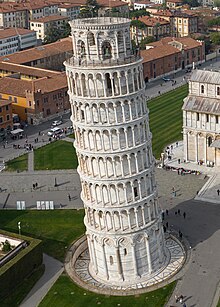
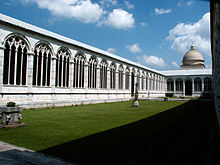
While thebell tower of the cathedral,known as "the leaning Tower of Pisa", is the most famous image of the city, it is one of many works of art and architecture in the city'sPiazza del Duomo,also known, since the 20th century, asPiazza dei Miracoli(Square of Miracles), to the north of the old town center. ThePiazza del Duomoalso houses theDuomo(the Cathedral), theBaptistryand theCampo Santo(the monumental cemetery). The medieval complex includes the above-mentioned four sacred buildings, the hospital and few palaces. All the complex is kept by theOpera (fabrica ecclesiae)della Primaziale Pisana,an old non profit foundation that has operated since the building of the Cathedral in 1063 to maintain the sacred buildings. The area is framed by medieval walls kept by the municipal administration.
Other sights include:
- Knights' Square(Piazza dei Cavalieri), where thePalazzo della Carovana,with its façade designed byGiorgio Vasarimay be seen. Sited on the square.
- Santo Stefano dei Cavalieri,church sited on Piazza dei Cavalieri, and also designed byVasari.It had originally a single nave; two more were added in the 17th century. It houses abustbyDonatello,and paintings by Vasari,Jacopo Ligozzi,Alessandro Fei,andPontormo.It also contains spoils from the many naval battles between the Cavalieri (Knights of St. Stephan) and the Turks between the 16th and 18th centuries, including the Turkish battle pennant hoisted fromAli Pacha's flagship at the 1571Battle of Lepanto.
- St. Sixtus.This small church, consecrated in 1133, is also close to the Piazza dei Cavalieri. It was used as a seat of the most important notarial deeds of the town, also hosting the Council of Elders. It is today one of the best preserved earlyRomanesquebuildings in town.
- St. Francis.The church of San Francesco may have been designed byGiovanni di Simone,built after 1276. In 1343 new chapels were added and the church was elevated. It has a single nave and a notable belfry, as well as a 15th-century cloister. It houses works byJacopo da Empoli,Taddeo GaddiandSanti di Tito.In the Gherardesca Chapel are buriedUgolino della Gherardescaand his sons.
- San Frediano.This church, built by 1061, has abasilicainterior with three aisles, with a crucifix from the 12th century. Paintings from the 16th century were added during a restoration, including works byVentura Salimbeni,Domenico Passignano,Aurelio Lomi,andRutilio Manetti.
- San Nicola.This medieval church built by 1097, was enlarged between 1297 and 1313 by theAugustinians,perhaps by the design ofGiovanni Pisano.The octagonal belfry is from the second half of the 13th century. The paintings include theMadonna with ChildbyFrancesco Traini(14th century) andSt. Nicholas Saving Pisa from the Plague(15th century). Noteworthy are also the wood sculptures by Giovanni andNino Pisano,and theAnnunciationbyFrancesco di Valdambrino.
- Santa Maria della Spina.A small white marble church alongside the Arno, is attributed to Lupo di Francesco (1230), is another excellent Gothic building.
- San Paolo a Ripa d'Arno.The church was founded around 952 and enlarged in the mid-12th century along lines similar to those of the cathedral. It is annexed to theRomanesqueChapel of St. Agatha, with an unusual pyramidal cusp or peak.
San Pietro in Vinculis.Known asSan Pierino,it is an 11th-century church with a crypt and acosmatesquemosaic on the floor of the main nave.
- Borgo Stretto.This medieval borgo or neighborhood contains strolling arcades and theLungarno,the avenues along the river Arno. It includes the Gothic-Romanesque church ofSan Michele in Borgo(990). There are at least two other leaning towers in the city, one at the southern end of centralVia Santa Maria,the other halfway through thePiaggeriverside promenade.
- Medici Palace. The palace was once a possession of the Appiano family, who ruled Pisa in 1392–1398. In 1400 the Medici acquired it, andLorenzo de' Medicisojourned here.
- Orto botanico di Pisa.The botanical garden of the University of Pisa is Europe's oldest universitybotanical garden.
- Palazzo Reale.The ( "Royal Palace" ), once belonged to theCaetanipatrician family. HereGalileo Galileishowed toGrand Duke of Tuscanythe planets he had discovered with his telescope. The edifice was erected in 1559 byBaccio BandinelliforCosimo I de Medici,and was later enlarged including other palaces. The palace is now a museum.
- Palazzo Gambacorti:14th-century Gothic palace, and now houses the offices of the municipality. The interior shows frescoes boasting Pisa's sea victories.
- Palazzo Agostini.15th-century Gothic palace that incoporates city walls predating 1155. It housesCaffè dell'Ussero,a coffeeshop founded in 1775, and for during the 19th-century a meeting spot for patriots and intelligentsia.
- MuralTuttomondo.A modern mural, the last public work byKeith Haring,on the rear wall of the convent of the Church ofSant'Antonio,painted in June 1989.
Museums
[edit]- Museo dell'Opera del Duomo:exhibiting among others the original sculptures ofNicola PisanoandGiovanni Pisano,the IslamicPisa Griffin,and the treasures of the cathedral.
- Museo delle Sinopie:showing thesinopiasfrom the camposanto, the monumental cemetery. These are red ocherunderdrawingsfor frescoes, made with reddish, greenish or brownish earth colour with water.
- Museo Nazionale di San Matteo:exhibiting sculptures and paintings from the 12th to 15th centuries, among them the masterworks ofGiovanniandAndrea Pisano,theMaster of San Martino,Simone Martini,Nino PisanoandMasaccio.
- Museo Nazionale di Palazzo Reale:exhibiting the belongings of the families that lived in the palace: paintings, statues, armors, etc.
- Museo Nazionale degli Strumenti per il Calcolo:exhibiting a collection of instruments used in science, between a pneumatic machine ofVan Musschenbroekand a compass which probably belonged toGalileo Galilei.
- Museo di storia naturale dell'Università di Pisa(Natural History Museum of the University of Pisa), located in theCertosa di Calci,outside the city. It houses one of the largest cetacean skeletons collection in Europe.
- Palazzo Blu:temporary exhibitions and cultural activities center, located in the Lungarno, in the heart of the old town, the palace is easy recognizable because it is the only blue building.
- Cantiere delle Navi di Pisa- The Pisa's Ancient Ships Archaeological Area: A museum of 10,650 square meters – 3,500 archaeological excavation, 1,700 laboratories and one restoration center – that visitors can visit with a guided tour.[19]The Museum opened in June 2019[20]and has been located inside to the 16th-century Medicean Arsenals in Lungarno Ranieri Simonelli, restored under the supervision of the TuscanySoprintendenza.[21]It hosts a remarkable collection of ceramics andamphorasdated back from the8th century BCEto the2nd century BC,[22]and also 32 ships dated back from the second century BCE and the seventh century BC.[23]Four of them are integrally preserved[24]and the best one is the so-calledBarca C,also namedAlkedo(written in theancient Greek characters).[25]The first boat was accidentally discovered in 1998 near thePisa San Rossore railway stationand the archeological excavations were completed 20 years later.[26]
Churches
[edit]


- Baptistry,with the famousPulpit in the Pisa Baptisteryof 1260, byNicola Pisano
- San Francesco
- San Frediano
- San Giorgio ai Tedeschi
- San Michele in Borgo
- San Nicola
- San Paolo a Ripa d'Arno
- San Paolo all'Orto
- San Piero a Grado
- San Pietro in Vinculis
- San Sisto
- San Tommaso delle Convertite
- San Zeno
- Santa Caterina
- Santa Cristina
- Santa Maria della Spina
- Santo Sepolcro
Palaces, towers and villas
[edit]

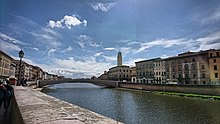

- Palazzo del Collegio Puteano
- Palazzo della Carovana
- Palazzo delle Vedove
- Torre dei Gualandi
- Villa di Corliano
- Leaning Tower of Pisa
Sports
[edit]This sectionneeds expansion.You can help byadding to it.(June 2008) |
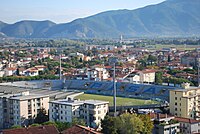
Football
[edit]Footballis the main sport in Pisa; the local team,A.C. Pisa,currently[27]plays in theSerie B(the second highest football division in Italy), and has had a top flight history throughout the 1980s and the 1990s, featuring several world-class players such asDiego Simeone,Christian VieriandDungaduring this time. The club play at theArena Garibaldi – Stadio Romeo Anconetani,opened in 1919 and with a capacity of 25,000.
Shooting
[edit]Shootingwas one of the first sports to have their own association in Pisa. TheSocietà del Tiro a Segnodi Pisa was founded on July 9, 1862. In 1885, they acquired their own training field. The shooting range was almost completely destroyed during World War II.
Transport
[edit]Airport
[edit]Pisa has an international airport known asPisa International Airportor normallyGalileo Galileilocated in San Giusto neighbourhood in Pisa. It is served by twenty-one airlines connecting eleven domestic and sixty-one international destinations (seasonal included).
Pisamover
[edit]The airport is connected toPisa Centrale railway stationby apeople moversystem 2 km (1.2 mi) long, calledPisamover[28]inaugurated in March 2017.[29]It is based on a driverless "horizontalfunicular"that travels the distance in 5 minutes, with a 5-minute frequency, having an intermediate stop at parking station San Giusto/Aurelia.
Buses
[edit]Consorzio Pisano Trasporti,also known asCPT,was aSocietà consortile a responsabilità limitata(Scarl) that operated since 2005 the local public transport in Pisa and in theprovince.Became subsidiary ofCompagnia Toscana Trasporti Nord[30]in 2012 and was one the companies of the consortiumONE Scarl[31]to accomplish the contract stipulated with theRegione Toscanafor the public transport in the 2018-2019 period. The fleet consisted of 70 urban, 15 suburban and 260 intercity buses.
Since 1 November 2021 the public local transport is managed byAutolinee Toscane.[32]
- Urban routes
- [33]
- LAM Rossa:Cisanello Hospital - Central Station – Duomo – Parking Pietrasantina
- LAM Verde:San Giusto - Central Station - Pratale
- Shuttle E:Lungarno Pacinotti – Park Brennero – La Fontina
- Night LAM:Cisanello–Lungarni (night service)
- Night LAM:Pietrasantina–Lungarni (night service)
- Shuttle Torre:Park Pietrasantina – Largo Cocco Griffi (Duomo)
- Shuttle Cisanello Hospital:Park Bocchette – Cisanello (Hospital)
- 2:San Giusto – Central Station – Porta a Lucca
- 4:Central Station – I Passi
- 5:Putignano – Central Station – C.E.P.
- 6:Central Station – C.E.P. – Barbaricina
- 8:Coltano – Vittorio Emanuele II square
- 12:Viale Gramsci – Ospedaletto (Expò) – Bus Depot CPT
- 13:Cisanello Hospital – Piagge – Central Station – Pisanova
- 14:Cisanello Hospital – Pisanova – Central Station – Piagge
- 16:Viale Gramsci – Ospedaletto – Industrial Zone (some to Località Montacchiello)
- 21:Airport – Central Station – C.E.P.–Duomo – I Passi (night service)
- 22:Central Station – Piagge–Pisanova–Cisanello–Pratale (night service)
- Suburban routes to/from Pisa
- [33]
- 10:Pisa–Tirrenia–Livorno (deviation to La Vettola - San Piero a Grado)
- 50:Pisa–Collesalvetti–Fauglia–Crespina
- 51:Collesalvetti–Lorenzana–Orciano
- 70:Pisa–Gello–Pontasserchio
- 71:Pisa – Sant'Andrea in Palazzi – Pontasserchio – San Martino Ulmiano: Pisa
- 80:Pisa–Migliarino–Vecchiano–Filettole
- 81:Pisa–Pontasserchio–Vecchiano
- 110:Pisa–Asciano–Agnano
- 120:Pisa–Calci–Montemagno
- 140:Pisa–Vicopisano–Pontedera
- 150:Pisa–Musigliano–Pettori
- 160:Pisa–Navacchio–Calci – Tre Colli
- 190:Pisa–Cascina–Pontedera
- 875:Pisa – Arena Metato
Trains
[edit]The city is served by two railway stations available for passengers:Pisa CentraleandPisa San Rossore.
Pisa Centraleis the main railway station and is located along theTyrrhenic railway line.It connects Pisa directly with several other important Italian cities such asRome,Florence,Genoa,Turin,Naples,Livorno,andGrosseto.
Pisa San Rossorelinks the city with Lucca (20 minutes north-east of Pisa) andViareggioand is also reachable fromPisa Centrale.It is a minor railway station located near the Leaning Tower zone.
There was another station calledPisa Aeroportosituated next to the Airport with services toPisa CentraleandFlorence.It was closed on December 15, 2013, for the realization of apeople mover.
Motorway
[edit]Pisa is connected toAutostrada A11fromFlorenceand toAutostrada A12linkingGenoa-Rosignanowith exit Pisa Nord and Pisa Centro –Airport.
Education
[edit]Pisa hosts theUniversity of Pisa,especially renowned in the fields ofPhysics,Mathematics,EngineeringandComputer Science.TheScuola Superiore Sant'Annaand theScuola Normale Superiore,the Italian academic élite institutions are noted mostly for research and the education ofgraduate students.
Construction of a new leaning tower of glass and steel 57 meters tall, containing offices and apartments was scheduled to start in summer 2004 and take 4 years. It was designed byDante Oscar Beniniand raised criticism.
- TheScuola Normale Superiore di Pisawas founded in 1810, by Napoleonic decree, as a branch of theÉcole Normale Supérieureof Paris. Recognized as a "national university" in 1862, one year after Italian unification, and named during that period as "Normal School of the Kingdom of Italy" (Superior Graduate Schools in Italyi.e. Scuola Superiore Universitaria).
Located at: Scuola Normale Superiore di Pisa – Piazza dei Cavalieri, 7 – 56126 Pisa (Italia)
- TheSant'Anna School of Advanced Studies of PisaorScuola Superiore Sant'Annais a special-statute public university located in Pisa, Italy, emerging fromScuola Normale Superiore di Pisaand operating in the field of applied sciences, (Superior Graduate Schools in Italyi.e. Scuola Superiore Universitaria)
Located at: Scuola Superiore Sant'Anna, P.zza Martiri della Libertà, 33 – 56127 – Pisa (Italia)
- TheUniversity of PisaorUniversità di Pisa,is one of the oldest universities in Italy. It was formally founded on September 3, 1343, by an edict of Pope Clement VI, although there had been lectures on law in Pisa since the 11th century. The university has Europe's oldest academic botanical garden i.e.Orto botanico di Pisa,founded 1544. The medical school of the university is sight atAzienda ospedaliero-universitaria pisana.
Located at: Università di Pisa – Lungarno Pacinotti, 43 – 56126 Pisa (Italia)
Notable people
[edit]For people born in Pisa, seePeople from the Province of Pisa;among notable non-natives long resident in the city:
- Giuliano Amato(born 1938), politician, former Premier and Minister of Interior Affairs
- Alessandro d'Ancona(1835–1914), critic and writer.[34]
- Silvano Arieti(1914–1981), psychiatrist
- Gaetano Bardini(1926–2017), tenor
- Andrea Bocelli(born 1958), tenor and multi-instrumentalist.
- Giosuè Carducci(1835–1907), poet and1906 Nobel Prize in Literaturewinner.[35]
- Massimo Carmassi(born 1943), architect
- Carlo Azeglio Ciampi(1920–2016), politician, former President of the Republic of Italy
- Maria Luisa Cicci(1760–1794), poet
- Giovanni Carlo Maria Clari(1677–1754), a musical composer andmaestro di cappellaatPistoia.[36]
- Alessio Corti(born 1965), mathematician
- Rustichello da Pisa(born 13th century), writer
- Giovanni Battista Donati(1826–1873), an Italian astronomer.[37]
- Leonardo Fibonacci(1170–1250), mathematician.[38]
- Galileo Galilei(1564–1642), physicist.[39]
- Giovanni Gentile(1875–1944), philosopher and politician
- Orazio Gentileschi(1563–1639), painter.[40]
- Count Ugolino della Gherardesca(1214–1289), noble (see alsoDante Alighieri).[41]
- Giovanni Gronchi(1887–1978), politician, former President of the Republic of Italy
- Giacomo Leopardi(1798–1837), poet and philosopher.[42]
- Enrico Letta(born 1966), politician, former Prime Minister of Italy
- Marco Malvaldi(born 1974),mysterynovelist
- Leonardo Ortolani(born 1967), comic writer
- Antonio Pacinotti(1841–1912), physicist, inventor of thedynamo
- Andrea Pisano(1290–1348), a sculptor and architect.[43]
- Afro Poli(1902–1988), an operatic baritone
- Bruno Pontecorvo(1913–1993), nuclear physicist
- Gillo Pontecorvo(1919–2006), filmmaker
- Ippolito Rosellini(1800–1843), an Egyptologist.[44]
- Paolo Savi(1798–1871), geologist and ornithologist.[45]
- Antonio Tabucchi(1943–2012), writer and academic
Sport
[edit]- Jason Acuña(born 1973), Stunt performer
- Sergio Bertoni(1915–1995), footballer
- Giorgio Chiellini(born 1984), footballer
- Camila Giorgi(born 1991), tennis player
Sister cities
[edit]
 Acre,Israel (1988)
Acre,Israel (1988) Akademgorodok (Novosibirsk),Russia (1991)
Akademgorodok (Novosibirsk),Russia (1991) Angers,France (1982)
Angers,France (1982) Hangzhou,China (2008)
Hangzhou,China (2008) Iglesias,Italy (2009)
Iglesias,Italy (2009) Jericho,Palestine (2000)
Jericho,Palestine (2000) Kolding,Denmark (2007)
Kolding,Denmark (2007) Niles,United States (1991)
Niles,United States (1991) Ocala,United States (2004)
Ocala,United States (2004) Rhodes,Greece (2009)
Rhodes,Greece (2009) Santiago de Compostela,Spain (2009)
Santiago de Compostela,Spain (2009) Unna,Germany (1996)
Unna,Germany (1996)
References
[edit]Notes
[edit]- ^"Statistiche demografiche ISTAT".demo.istat.it.[permanent dead link]
- ^"Popolazione Residente al 1° Gennaio 2018".Italian National Institute of Statistics.RetrievedMarch 16,2019.
- ^"DiPI Online".Dizionario di Pronuncia Italiana(in Italian).RetrievedDecember 26,2020.
- ^Scuola Superiore Sant'Anna di PisaArchivedJanuary 1, 2016, at theWayback MachineInformation statistics
- ^"STORIA DI PISA DALLA NASCITA AD OGGI".May 11, 2018.RetrievedJanuary 21,2022.
- ^Paribeni, Emanuela.La necropoli villanoviana di Pisa, Porta a Lucca/via Marche, in Cavalieri etruschi dalle valli al Po. Tra Reno e Panaro, la valle del Samoggia nell'VIII e VII secolo a.C.(in Italian). Edizioni Aspasia. pp. 258–263.
- ^Dictionary of Greek and Roman Geography (1854), alpheius
 This article incorporates text from this source, which is in thepublic domain.
This article incorporates text from this source, which is in thepublic domain.
- ^William Heywood (2010).A History of Pisa: Eleventh and Twelfth Centuries.Cambridge University Press. p. 1.ISBN9781108010139.
- ^abMachiavelli, Niccolò (1981).The Prince and Selected Discourses(Bantam Classic ed.). New York: Bantam Books. pp. 128–29.ISBN0-553-21227-3.
- ^"A traveler's oasis in Italy".Wiesbaden.army.mil. Archived fromthe originalon February 19, 2013.RetrievedMarch 12,2013.
- ^"Darby Military Community, Camp Darby, Italy, Top Picks".Usag.livorno.army.mil. April 30, 1945. Archived fromthe originalon February 2, 2013.RetrievedMarch 12,2013.
- ^"Temperature massime e minime mensili Pisa Scuola Sup. d'Agraria 1924-1996"(in Italian). Istituto Superiore per la Protezione e la Ricerca Ambientale (ISPRA). July 30, 2015. Archived fromthe originalon July 30, 2015.
- ^"Temperature massime e minime giornaliere per Pisa - Facoltà di Agraria nel periodo 2001-2008"(in Italian). Servizio Idrologico Regionale (SIR) - Regione Toscana. May 4, 2012. Archived fromthe originalon May 4, 2012.
- ^"WMO Climate Normals for 1991-2020: Pisa S. Giusto"(CSV).ncei.noaa.gov(Excel).National Centers for Environmental Information.RetrievedMarch 1,2024.
- ^"WMO Climate Normals for 1981-2010: Pisa S. Giusto-16158"(XLS).ncei.noaa.gov(Excel).National Centers for Environmental Information.RetrievedMarch 1,2024.
- ^Heywood, William (1905).Palio and Ponte: An Account of the Sports of Central Italy from the Age of Dante to the XXth Century.London: Methuen & Co. pp. 116–126.
- ^J. Theodore Bent,‘The Pisan Game’.Archæological Review,1888, Issue 2 (10) (Sep), 57-66.
- ^De Bruijn, Cornelis(1698). "4th chapter; Departure from Rome to Livorno. Ball game there. Bridge fight in Pisa. [...]".Reizen van Cornelis de Bruyn door de vermaardste deelen van Klein Asia [...].Amsterdam. Archived fromthe originalon September 9, 2023.
- ^"Navi Pisane - Le Antiche Navi Romane scoperte a Pisa".navipisa.it.Archived fromthe originalon August 20, 2018.RetrievedMay 6,2015.
- ^"Apre il Museo delle Navi Antiche di Pisa, ma non chiamatela Pompei del mare!"(in Italian). June 19, 2019. Archived fromthe originalon May 7, 2021.RetrievedMay 7,2021.
- ^"Pisa, negli Arsenali medicei apre il museo delle navi antiche"(in Italian). June 18, 2019.RetrievedMay 7,2021.
- ^"Le navi romane di Pisa"(in Italian).Archivedfrom the original on May 7, 2021.
- ^Nocito, Francesco (August 19, 2019)."Un grande museo per le navi di Pisa".archeostorie.it(in Italian).Archivedfrom the original on November 3, 2019.
- ^Randazzo, Alessandra (June 17, 2019)."Viaggio vall'internodel Museo delle Navi Antiche di Pisa"(in Italian).Archivedfrom the original on June 21, 2019.
- ^Bonino, Marco."Ricostruzione della barca C di Pisa S. Rossore"(PDF)(in Italian).Archived(PDF)from the original on May 7, 2021.
- ^"A Pisa è" Alkedo "la star nel Museo delle Navi Antiche".September 9, 2019.Archivedfrom the original on May 7, 2021.
- ^as of 2019[update]–20
- ^"Pisamover".Pisamover.RetrievedMay 30,2022.
- ^"MM100 PisaMover".LEITNER ropeways.Archived fromthe originalon February 13, 2018.RetrievedFebruary 12,2018.
- ^"Elenco Soci".CTT Nord. Archived fromthe originalon May 24, 2022.RetrievedMay 30,2022.
- ^"Muoversi in Toscana".ONE Scarl.RetrievedMay 24,2022.
- ^"Guida al primo giorno di servizio".Autolinee Toscane.RetrievedMay 30,2022.
- ^ab"Pisa Orari".CTT Nord. Archived fromthe originalon May 23, 2022.RetrievedMay 30,2022.
- ^.Encyclopædia Britannica.Vol. 1 (11th ed.). 1911. p. 951.
- ^.Encyclopædia Britannica.Vol. 5 (11th ed.). 1911. pp. 326–327.
- ^.Encyclopædia Britannica.Vol. 6 (11th ed.). 1911. pp. 436–437.
- ^Clerke, Agnes Mary(1911)..Encyclopædia Britannica.Vol. 8 (11th ed.). p. 408.
- ^Cantor, Moritz(1911)..Encyclopædia Britannica.Vol. 16 (11th ed.). pp. 454–455.
- ^Clerke, Agnes Mary(1911)..Encyclopædia Britannica.Vol. 12 (11th ed.). pp. 406–410.
- ^.Encyclopædia Britannica.Vol. 11 (11th ed.). 1911. pp. 602–603.
- ^Villari, Luigi(1911)..Encyclopædia Britannica.Vol. 7 (11th ed.). pp. 965–966.
- ^Garnett, Richard(1911)..Encyclopædia Britannica.Vol. 16 (11th ed.). pp. 456–458.
- ^.Encyclopædia Britannica.Vol. 21 (11th ed.). 1911. pp. 647–648.
- ^.Encyclopædia Britannica.Vol. 23 (11th ed.). 1911.
- ^.Encyclopædia Britannica.Vol. 24 (11th ed.). 1911. p. 242.
- ^"Gemellaggi"(in Italian). Pisa. Archived fromthe originalon December 16, 2019.RetrievedMarch 21,2022.
Bibliography
[edit]- Renouard, Yves (1969).Les Villes d'Italie de la fin du Xe siècle au début du XIVe siècle(in French).
- Official Abitants statistics
- Pisa Metropolitan AreaArchivedAugust 31, 2012, at theWayback Machine
External links
[edit]- Portal of Pisa
- Pisan history portal
- Official site of the Pisa Tourist Board
- Official site of the Municipality of Pisa, including webcams
- Moving Postcards of PisaArchivedMay 23, 2016, at the Portuguese Web Archive
- Pisa Guide
- A comprehensive guide of Pisa
the centre of mass of the leaning tower of pisa is located in the 4th floor (not american system)



